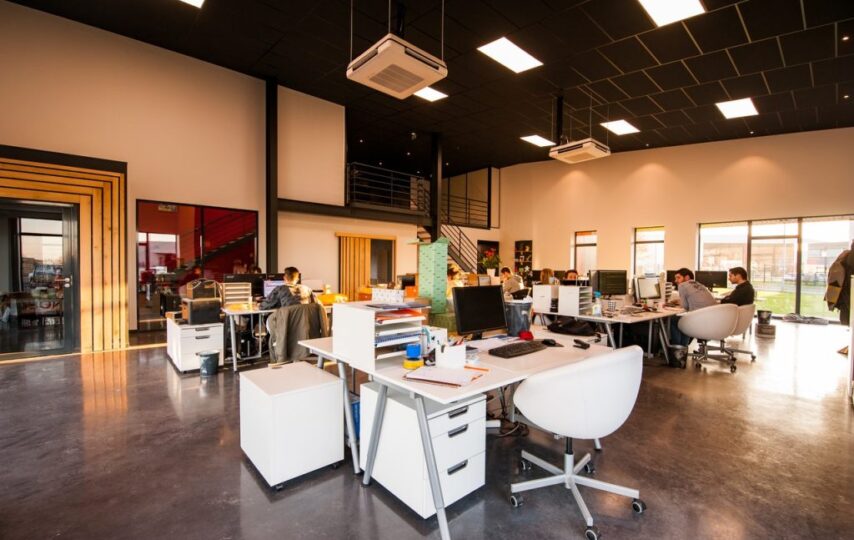The modern workplace is more than just a physical location where work is done; it’s a dynamic environment that plays a pivotal role in employee satisfaction, productivity, and business success. Office renovation and improvements are essential to creating a workspace that fosters innovation, collaboration, and well-being. This comprehensive guide will delve into the world of office renovations and explore how thoughtful design, technology integration, and employee-centric improvements can transform your office into a thriving hub of productivity and creativity.
The Importance of Office Renovation
Your office space reflects your company’s culture and values, and an outdated or uninspiring environment can have a negative impact on your business. Here are several reasons why office renovation is crucial:
- Enhanced Productivity: A well-designed office layout can streamline workflows, reduce distractions, and boost employee efficiency.
- Improved Employee Satisfaction: A fresh and modern workspace demonstrates your commitment to employee well-being, leading to higher morale and retention rates.
- Attracting Top Talent: A modern and appealing office can be a powerful recruitment tool, attracting top-tier talent to your organization.
- Reflecting Your Brand: An updated office can align with your brand identity and create a memorable impression on clients and visitors.
- Energy Efficiency: Renovations offer an opportunity to implement energy-efficient solutions, reducing utility costs and environmental impact.
Planning Your Office Renovation
Before diving into your office renovation project, careful planning is essential to ensure a smooth process and successful outcomes. These are the key considerations for a successful renovation:
- Define Your Goals: Clearly articulate the goals and objectives of the renovation. Are you aiming to increase space, improve aesthetics, enhance functionality, or all of the above?
- Set a Budget: Determine your budget and allocate funds for each aspect of the renovation, including design, construction, furnishings, and contingencies.
- Create a Timeline: Establish a realistic timeline that accounts for design, permitting, construction, and any potential delays.
- Hire Professionals: Engage architects, interior designers, and contractors with experience in office renovations to guide you through the process. Ensure specialist jobs are completed by qualified technicians, such as https://www.quantum-electrical.co.uk/.
- Consider Employee Input: Solicit feedback from employees about their preferences and needs to create a space that caters to their requirements.
Think About Office Design and Layout
The design of your office greatly influences employee satisfaction and productivity, so it plays a critical role. Consider these design principles:
- Open Layouts: Embrace open floor plans with flexible workstations to encourage collaboration and adaptability.
- Natural Light: Maximize natural light by incorporating large windows and glass partitions to boost employee well-being and reduce energy costs.
- Ergonomics: Invest in ergonomic furniture and workstations to promote comfort and reduce the risk of repetitive strain injuries.
- Biophilic Design: Integrate elements of nature into your office, such as plants and natural materials, to improve mood and creativity.
- Diverse Spaces: Design a variety of workspaces, including quiet areas for focused work, meeting rooms, lounge spaces, and collaborative zones.
Technological Advancements for Efficiency
In today’s digital age, technology plays a vital role in office renovations. Here are some technological advancements to consider:
- Smart Office Solutions: Implement smart office systems for lighting, climate control, and security, offering convenience and energy savings.
- Collaboration Tools: Equip meeting rooms with advanced audio-visual systems and collaboration tools for seamless communication – particularly important if remote employees need to attend meetings and work on projects at the same time as office employees.
- Wireless Charging: Install wireless charging stations throughout the office to keep devices powered up.
- Data Security: Prioritize data security by integrating advanced cybersecurity measures and robust network infrastructure.
Sustainable Practices: Creating an Eco-Friendly Office
Sustainability is a growing concern in office design. Here’s how you can incorporate eco-friendly practices into your renovation:
- Energy-Efficient Lighting: Opt for LED lighting and motion sensors to reduce energy consumption.
- Green Materials: Choose sustainable and recycled materials for flooring, furniture, and finishes.
- Waste Reduction: Implement recycling and waste reduction programs to minimize your environmental footprint.
- Natural Ventilation: Design your office to maximize natural ventilation, reducing the need for air conditioning.
Prioritize Employee Well-Being and Comfort
The well-being of your employees should be at the forefront of your office renovation efforts:
- Ergonomic Furnishings: Invest in ergonomic chairs, sit-stand desks, and keyboard trays to enhance comfort and reduce strain.
- Wellness Spaces: Consider wellness amenities such as meditation rooms, fitness areas, and relaxation zones.
- Healthy Food Options: Provide access to nutritious snacks and promote healthy eating options in the workplace.
- Noise Control: Implement sound-absorbing materials and acoustic design elements to reduce noise levels and improve concentration.
Maximizing Efficiency and Productivity
To optimize efficiency and productivity, focus on these aspects of your office renovation:
- Workflow Analysis: Analyze your organization’s workflow to design spaces that facilitate seamless processes and reduce bottlenecks.
- Meeting Spaces: Ensure the availability of well-equipped meeting spaces to facilitate collaboration and client interactions.
- Storage Solutions: Incorporate ample storage options to keep workspaces clutter-free and organized.
- Brand Identity: Use branding elements throughout the office to reinforce company culture and values.
Navigating Challenges and Managing Disruptions
Renovating your office may pose challenges, such as disruptions to daily operations. However, you will want to do all you can to minimize disruptions during renovation. Here are strategies to mitigate these issues:
- Phased Renovation: Consider a phased renovation approach to allow for the continuation of essential business activities.
- Temporary Workspaces: Arrange temporary workspaces for employees during construction phases.
- Communication: Maintain transparent communication with employees regarding renovation schedules and any potential disruptions.
Conclusion
Office renovation and improvements offer the opportunity to transform your workspace into a dynamic, inspiring, and efficient environment that enhances employee well-being and boosts productivity. By carefully planning your renovation, embracing innovative design principles, incorporating advanced technology, and prioritizing sustainability and employee comfort, you can create an office that meets your business needs and positions your organization for long-term success in an ever-evolving workplace landscape.
Remember that a well-designed office is an investment in your company’s future, fostering innovation and growth.








